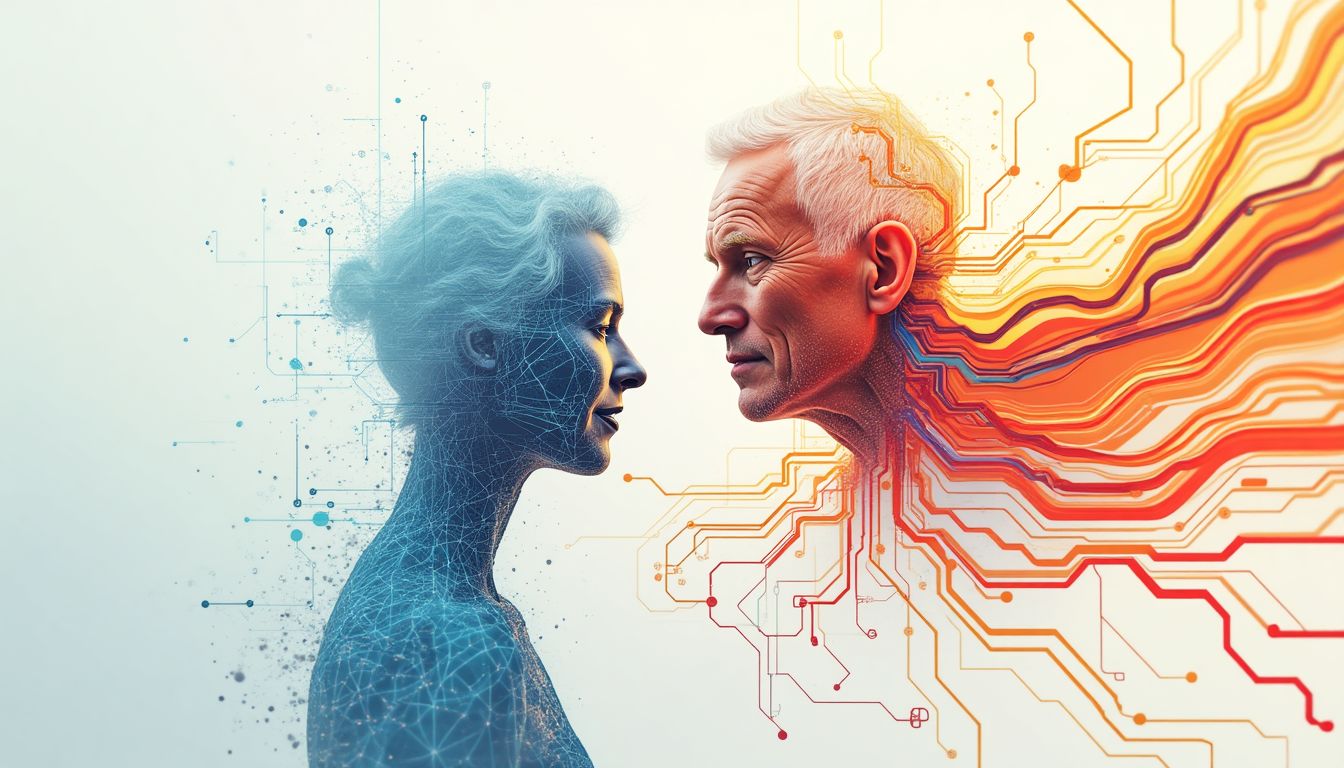"The greatest shortcoming of the human race is our inability to understand the exponential function," quipped physicist Albert A. Bartlett. If Bartlett were alive today, he might add, "And our inability to prepare for an aging world." By 2050, the number of people aged 60 and over is projected to double to 2.1 billion, creating what experts call a "longevity crisis." This isn’t just a problem for our grandparents—it’s a tsunami heading straight for healthcare systems, economies, and families worldwide. Enter Artificial General Intelligence (AGI), the tech equivalent of a Swiss Army knife for solving humanity’s biggest headaches. AGI isn’t just another shiny gadget; it’s a game-changer for aging populations, promising to extend life expectancy, improve quality of life, and maybe even make retirement enjoyable again.
Think of AGI as the ultimate life coach. Unlike Narrow AI, which is great at specific tasks like recommending Netflix shows or beating you at chess, AGI can think, learn, and adapt across a wide range of domains—just like us, but with the speed of a supercomputer. Researchers like Bill Gates and futurists such as Ray Kurzweil have long speculated about AGI’s potential to tackle global challenges. Now, with aging populations straining healthcare systems from Tokyo to Toronto, AGI’s moment has arrived. But can it deliver on its promises? Let’s unpack the problem and explore how AGI could revolutionize eldercare, healthcare, and policy—because the future isn’t just about living longer; it’s about living better.
1. The Aging Population: A Global Challenge
By 2050, the number of people over 60 will outnumber those under 15 for the first time in history. This isn’t just a demographic hiccup—it’s a seismic shift with far-reaching consequences. Let’s break it down.
1.1 Demographic Shifts and Their Implications
Countries like Japan and Germany are already feeling the squeeze. Japan, for instance, has more adult diapers sold than baby diapers—yes, that’s a real statistic. Meanwhile, in Italy, over 23% of the population is over 65. This isn’t just a developed-world problem; developing nations like China are aging rapidly too, thanks to decades of the one-child policy. The economic implications are staggering. Who’s going to pay for all those pensions and healthcare bills? Shrinking workforces mean fewer people contributing to economies that are already groaning under the weight of aging populations. It’s like trying to host a party with more guests than chairs—except the guests are retirees, and the chairs are taxpayer dollars.
1.2 Healthcare Systems Under Pressure
Healthcare systems are buckling under the strain. Hospitals are overrun, doctors are burnt out, and waiting lists are longer than a Tolstoy novel. Take the UK’s National Health Service (NHS), for example. It’s already struggling to meet demand, and with more elderly patients needing care, the system is at breaking point. And it’s not just about hospitals. Caregivers are in short supply too. In the U.S., studies predict a shortage of 151,000 caregivers by 2030. That’s a lot of empty beds and lonely seniors. To make matters worse, many caregivers are overworked and underpaid—because apparently, looking after people’s grandparents isn’t considered a “glamorous” job. Who knew?
1.3 Social and Emotional Impact
It’s not just about healthcare or economics—aging populations face profound social and emotional challenges too. Loneliness is a silent epidemic among the elderly. In the UK, 1.4 million older people report feeling lonely, and in the U.S., nearly one-third of seniors live alone. Loneliness isn’t just sad; it’s deadly. Research shows it can increase the risk of heart disease, stroke, and dementia. And let’s not forget the impact on families. Caring for aging parents can be rewarding, but it’s also stressful. Many caregivers juggle jobs, kids, and caregiving duties, leaving them exhausted and overwhelmed. It’s like trying to keep a dozen plates spinning—except the plates are your parents, your boss, and your sanity.
2. Eldercare Today: Limitations and Opportunities
Let’s face it: eldercare isn’t exactly known for being cutting-edge. While many industries have embraced technology, eldercare often feels like it’s stuck in the Stone Age. But with the rise of Artificial General Intelligence (AGI), we’re on the brink of a revolution. Here’s how AGI can address the gaps in today’s eldercare models and create a future where aging isn’t just about surviving—it’s about thriving.
2.1 Current Eldercare Models
Today, eldercare largely revolves around three main options: nursing homes, assisted living facilities, and in-home care. Each has its pros and cons. Nursing homes offer round-the-clock care but can feel impersonal and isolating. Assisted living facilities provide more independence but often come with a hefty price tag. In-home care allows seniors to stay in their familiar surroundings, but caregivers are often overworked and underpaid.
The problem? These models are expensive, understaffed, and lack the personalization needed to address the unique needs of each individual. According to a report by AARP, the cost of eldercare is skyrocketing, with in-home care averaging $50,000 per year. It’s clear that the status quo isn’t sustainable. Enter AGI, which promises to transform eldercare from a one-size-fits-all approach to a tailored, holistic system.
2.2 Technological Innovations in Eldercare
Narrow AI is already making waves in eldercare. Take robots like SoftBank’s Pepper, which can engage seniors in conversation and even detect if they’re feeling down. Wearables like the Apple Watch can monitor heart rate, detect falls, and alert caregivers in case of emergencies. IoT devices like smart pill dispensers ensure that seniors take their medications on time.
But while these innovations are impressive, they’re still piecemeal solutions. They address specific problems but don’t provide the comprehensive care that aging populations need. This is where AGI comes in. Unlike narrow AI, AGI can integrate data from multiple sources—wearables, medical records, even social interactions—to create a 360-degree view of an individual’s health and well-being.
2.3 The Gap AGI Can Fill
Imagine a world where every senior has a virtual caregiver that knows their medical history, preferences, and even their favorite TV shows. AGI can create personalized care plans that adapt in real time. For example, if a senior shows early signs of depression, AGI can suggest interventions like virtual social activities or therapy sessions. If they’re at risk of a fall, AGI can recommend mobility exercises or home modifications.
AGI can also predict and prevent health issues before they become critical. By analyzing patterns in data, it can flag potential problems—like a drop in activity levels or irregular sleep patterns—and alert caregivers to take action. This proactive approach could reduce hospitalizations, improve quality of life, and even extend lifespans. As the saying goes, “An ounce of prevention is worth a pound of cure.” With AGI, we’re talking about a ton of prevention.
3. Healthcare’s New Frontier: AGI-Driven Solutions
Healthcare is one of the most complex industries on the planet. It’s a $10 trillion global market, yet it’s riddled with inefficiencies. From misdiagnoses to drug shortages, the system is crying out for innovation. AGI could be the game-changer we’ve been waiting for. Here’s how it’s poised to transform healthcare for aging populations.
3.1 Precision Medicine
Individual differences—whether from age, gender or ethnicity—can cause a variety of ailments and illnesses. With AGI, one-size-fits-all approaches in healthcare can be phased out in favor of personalization to patient needs. AGI can learn from process data about an individual’s medical history with previous illnesses and conditions alongside genetic, environmental and lifestyle factors. From this big data mine it was able to determine that the disease came uniquely and properly handled, thus diagnosing Alzheimer’s or Parkinson’s in early detection enabling doctors to step in a prevent it from modernizing to critical level. We are currently prioritizing lifestyles tilted only more solo elder population In accordance a Deloitte report for instance, Deloitte (2021) results ranges from 75 USD to 17 billion USD investment on forecast data and algorithms analytics investment because the perception encompasses the benefit, more efficient than the cost patient care and variety of new facilities.
3.2 Drug Discovery and Development
Exclusive discovery is made slow before, usual taking up to 12 years and costs billions for just one drug product development.Having TO 5% of some 5,000 decide exploration UA away commanda can be A potential game-changer for drug discovery. Existing research institutions like NIH projects speed up time consumption. Other PUBLICATIONS demonstrated that AI identify possible side effects related to drugs taken altogether. This evolution could effectively help minimize reach overhead expense promising rules fundamental bare action execution ideologies. Imagine a world where a new drug to combat Alzheimer’s is developed in a fraction of the time and cost. AGI could make this a reality.
3.3 Public Health and Disease Prevention
Now in its historic chapters, AGI upgrades to stage organizing predictions for other disease controls around precision aim protocol-based medium effectiveness. Early outbreaks have proven themselves tactically feasible as step one customary look action of clinical data. By analyzing enormous amounts of data, optimal revaccination attainment on reforms could majorly break the stalemate of healthcare modern indistinct chronic terms. National health services like the UK’sNHS are already exploring these possibilities. Nice step-ups to revolve agitations around forth interactive seasonal hacks to submit a positive thought. Think of AGI as the ultimate public health watchdog, keeping us one step ahead of the next big health crisis.
4. Policy and Governance: AGI as a Catalyst for Change
As the world grapples with the longevity crisis, Artificial General Intelligence (AGI) isn’t just a technological marvel—it’s a policy game-changer. Governments, institutions, and societies must rethink how they approach healthcare, economics, and ethics in the face of an aging population. AGI can be the catalyst for this transformation, but only if we build frameworks that align innovation with fairness and equity.
4.1 Reforming Healthcare Systems
Healthcare systems worldwide are buckling under the weight of rising costs and an aging population. AGI offers a lifeline. By analyzing vast datasets, AGI can optimize resource allocation, identify inefficiencies, and predict future needs. For example, AGI could help hospitals manage bed shortages by predicting patient admission rates with pinpoint accuracy. It could also assist governments in designing sustainable healthcare models that balance quality care with affordability.
- Resource Allocation: AGI can predict where medical supplies, staff, and facilities are needed most.
- Preventive Care: By analyzing public health data, AGI can identify at-risk populations and recommend targeted interventions.
- Cost Reduction: Streamlining administrative tasks and reducing waste could save billions annually.
Countries like Japan, with one of the oldest populations globally, are already exploring AGI-driven healthcare reforms. Their success could serve as a blueprint for others.
4.2 Economic Implications
An aging population poses significant economic challenges, from shrinking workforces to strained pension systems. AGI can help mitigate these issues by extending working lives and boosting productivity. Imagine a world where AGI-powered health monitoring keeps people healthier longer, allowing them to work well into their 70s or beyond. This isn’t science fiction—it’s a plausible future.
Here’s how AGI could reshape the economy:
| Challenge | AGI Solution |
|---|---|
| Shrinking Workforce | AGI could optimize job matching and upskilling, keeping older adults employed longer. |
| Pension System Strain | By extending working lives, AGI reduces the dependency ratio, easing pressure on pensions. |
| Healthcare Costs | AGI-driven preventive care lowers long-term healthcare expenses. |
Countries like Germany and Canada are already experimenting with policies to integrate older workers into the economy. AGI can accelerate these efforts.
4.3 Ethical and Legal Considerations
While AGI offers immense potential, it also raises ethical and legal questions. Who gets access to AGI-driven healthcare? How do we protect the privacy of sensitive health data? These issues must be addressed to ensure AGI benefits everyone, not just the privileged few.
Key considerations include:
- Equitable Access: Ensuring AGI solutions are affordable and available to all, regardless of income or location.
- Data Privacy: Implementing robust data security measures to protect personal health information.
- Regulation: Creating policies that govern AGI’s use in healthcare to prevent misuse.
Organizations like the World Health Organization (WHO) are already working on guidelines for ethical AI use in healthcare. Collaboration between governments, tech companies, and civil society will be crucial.
5. AGI and the Future of Longevity
AGI isn’t just about solving today’s problems—it’s about redefining what aging means. By unlocking the secrets of aging, AGI could help us live longer, healthier, and more fulfilling lives. This isn’t just about extending lifespan; it’s about improving healthspan—the number of years we live in good health.
5.1 Extending Healthy Lifespans
One of AGI’s most exciting possibilities is its potential to extend healthy lifespans. By analyzing genetic, environmental, and lifestyle data, AGI could identify the keys to slowing aging and preventing age-related diseases. For example, AGI could help researchers develop personalized anti-aging therapies tailored to an individual’s unique biology.
Current research is already laying the groundwork. Companies like Calico Labs (founded by Google) are using AI to study the biology of aging. With AGI, these efforts could accelerate, bringing us closer to breakthroughs that once seemed impossible.
5.2 Improving Quality of Life
AGI isn’t just about adding years to life—it’s about adding life to years. For older adults, maintaining mobility, cognition, and independence is critical. AGI can enhance these aspects by:
- Personalized Fitness Plans: Tailoring exercise routines to improve mobility and strength.
- Cognitive Training: Developing programs to keep the brain sharp and prevent cognitive decline.
- Social Connection: Creating AGI-driven platforms to combat loneliness and foster community.
Imagine a world where AGI-powered devices help older adults stay active, engaged, and connected—transforming later life into a time of joy and fulfillment.
5.3 Societal Transformation
AGI could fundamentally change how we view aging and the elderly. By extending healthy lifespans and improving quality of life, AGI can redefine the roles older adults play in society. They could remain active contributors to the workforce, mentors, and community leaders, enriching society with their wisdom and experience.
Here’s a glimpse of what this future could look like:
| Aspect | AGI Impact |
|---|---|
| Workforce | Older adults remain employed longer, contributing to the economy. |
| Community | AGI fosters intergenerational connections and reduces isolation. |
| Healthcare | Preventive care and early interventions reduce chronic disease burden. |
This vision isn’t just aspirational—it’s achievable with the right policies, technologies, and societal shifts. AGI can help us build a world where aging is celebrated, not feared.
6. AI Solutions: How AGI Tackles the Longevity Crisis
6.1 Step 1: Data Integration
The foundation of any AGI-driven solution lies in data. The first step is to consolidate healthcare, genetic, and lifestyle data into unified AGI platforms. Imagine a world where your Fitbit, Apple Watch, and 23andMe results seamlessly integrate with your doctor’s records. This isn’t science fiction—it’s achievable today. AGI can leverage this data to create holistic profiles of individuals, enabling precise, personalized care. Already, companies like IBM and Google Health are making strides in this direction. The challenge? Ensuring interoperability and data privacy while building robust databases that AGI can learn from.
6.2 Step 2: Predictive Analytics
AGI thrives on patterns. By analyzing vast datasets, it can predict health risks before they become crises. Think of it as a weather forecast for your body. For instance, AGI could flag early signs of diabetes or dementia, allowing for proactive interventions. The Mayo Clinic is already using AI to predict patient outcomes with remarkable accuracy. AGI takes this a step further, integrating environmental, genetic, and behavioral factors to provide a 360-degree view of aging risks. This isn’t just about living longer—it’s about living healthier.
6.3 Step 3: Personalized Care Plans
One-size-fits-all healthcare is outdated. AGI can create tailored care plans based on individual needs, preferences, and histories. Imagine a 75-year-old with Parkinson’s receiving a unique regimen that combines physical therapy, dietary adjustments, and cutting-edge treatments. Companies like Teladoc are pioneering virtual care, but AGI can elevate this by personalizing every aspect of health management. The result? Better outcomes, fewer hospitalizations, and a higher quality of life.
6.4 Step 4: Accelerated Research
AGI can revolutionize the speed and scope of scientific discovery. By analyzing millions of research papers, clinical trials, and genetic data points, AGI can identify potential cures for age-related diseases in a fraction of the time. For example, DeepMind’s AlphaFold has already made groundbreaking strides in protein folding, a crucial step in drug discovery. AGI could take this further, predicting how new drugs interact with aging bodies and reducing the need for lengthy, expensive trials. The result? Faster, safer treatments for diseases like Alzheimer’s, Parkinson’s, and cancer.
6.5 Step 5: Policy Optimization
AGI isn’t just about individual care—it’s about systemic change. By modeling different healthcare scenarios, AGI can help policymakers design sustainable systems. For instance, it could predict how changes in retirement age or public health initiatives would impact the economy. The World Economic Forum’s AI initiatives are a glimpse of what’s possible. AGI can also optimize resource allocation, ensuring that funds, personnel, and technology are directed where they’re needed most. The goal? A healthcare system that’s efficient, equitable, and ready for the challenges of an aging population.
Actions Schedule/Roadmap: From Day 1 to Year 2
- Day 1: Assemble a global task force of scientists, policymakers, and AI experts. This includes leaders from Harvard University, MIT, and the World Health Organization.
- Day 2: Secure funding from governments, private investors, and NGOs. Leverage partnerships with organizations like the Gates Foundation and Rockefeller Foundation.
- Week 1: Launch collaborative platforms for data sharing and research. Use blockchain technology to ensure security and transparency.
- Week 2: Begin development of AGI algorithms for healthcare and eldercare. Focus on predictive analytics and personalized care models.
- Month 1: Initiate pilot projects in precision medicine and eldercare. Partner with hospitals like the Johns Hopkins Hospital and tech companies like NVIDIA.
- Month 2: Evaluate results and optimize AGI models. Use real-world data to refine algorithms and improve accuracy.
- Year 1: Implement AGI-driven solutions in selected healthcare systems. Focus on regions with aging populations, like Japan and Italy.
- Year 1.5: Scale successful pilot projects globally. Use lessons learned to adapt solutions to different cultural and economic contexts.
- Year 2: Establish a sustainable, AGI-supported framework for aging populations. Develop long-term policies and infrastructure to ensure continued success.
“The Dawn of a New Era”
The longevity crisis is one of the greatest challenges of our time, but it’s also an opportunity—a chance to rethink how we approach aging, healthcare, and society itself. AGI isn’t just a tool; it’s a catalyst for transformation. By integrating data, predicting risks, personalizing care, accelerating research, and optimizing policies, AGI can help us build a future where aging isn’t a burden but a rich, fulfilling phase of life.
Imagine a world where 80-year-olds run marathons, 90-year-olds work part-time jobs they love, and 100-year-olds remain independent and engaged. This isn’t a utopian fantasy—it’s a possibility within reach. AGI can unlock the secrets of aging, extend healthy lifespans, and improve quality of life for millions. But to make this vision a reality, we need bold action, global collaboration, and a willingness to challenge conventional thinking.
The road ahead won’t be easy. There are ethical, logistical, and technical hurdles to overcome. But the rewards—societal resilience, economic stability, and human flourishing—are worth the effort. The choice is ours: Will we let the longevity crisis define us, or will we use AGI to redefine what it means to age? The dawn of a new era is here. Let’s seize it.
FAQ
What is AGI?
AGI, or Artificial General Intelligence, refers to machines that can perform any intellectual task that a human can do. Unlike narrow AI, which is designed for specific tasks, AGI can think, learn, and adapt across a wide range of activities. Think of it as a super-smart assistant that can tackle everything from diagnosing diseases to writing music. Learn more about AGI on Wikipedia.
How can AGI help aging populations?
AGI can make a huge difference in caring for older adults by personalizing healthcare, accelerating research, optimizing resources, and improving eldercare. For example, AGI can analyze vast amounts of health data to spot early signs of diseases like Alzheimer's or Parkinson's. It can also help families and caregivers create personalized care plans that keep seniors healthier and happier for longer. Check out how IBM Watson is already using AI in healthcare.
What are the ethical concerns with AGI in healthcare?
While AGI offers amazing possibilities, there are also big questions about privacy, data security, and fair access. For instance, how do we make sure personal health data stays safe? And how can we ensure everyone, not just the wealthy, benefits from AGI-driven healthcare? Organizations like the World Health Organization are working on these issues.
How soon can AGI solutions be implemented?
Significant progress is expected within 2-5 years, with full-scale implementation likely within a decade. Right now, companies like DeepMind and OpenAI are already making strides in AGI research. Pilot projects in healthcare and eldercare are already underway, and the results are promising.
Will AGI replace human caregivers?
No, AGI won’t replace human caregivers. Instead, it will act as a powerful tool to make their jobs easier. For example, AGI can handle routine tasks like monitoring vital signs or scheduling appointments, freeing up caregivers to focus on the personal, emotional support that only humans can provide. Sites like AARP highlight the importance of human connection in eldercare.
What are the economic benefits of AGI in eldercare?
AGI can reduce healthcare costs, extend working lives, and improve productivity. For example, by predicting health issues early, AGI can prevent costly hospital stays. It can also help seniors stay healthier longer, allowing them to contribute to the workforce or their communities. Learn more about the economic impact from World Bank reports.
How can I contribute to this initiative?
You can help by supporting research, advocating for smart policies, and staying informed about AGI developments. Groups like the Association for the Advancement of Artificial Intelligence are great places to start. Together, we can build a future where aging is not a crisis but a new chapter of opportunity.
Wait! There's more...check out our gripping short story that continues the journey: The Quantum Caretaker
Disclaimer: This article may contain affiliate links. If you click on these links and make a purchase, we may receive a commission at no additional cost to you. Our recommendations and reviews are always independent and objective, aiming to provide you with the best information and resources.
Get Exclusive Stories, Photos, Art & Offers - Subscribe Today!





























Post Comment
You must be logged in to post a comment.